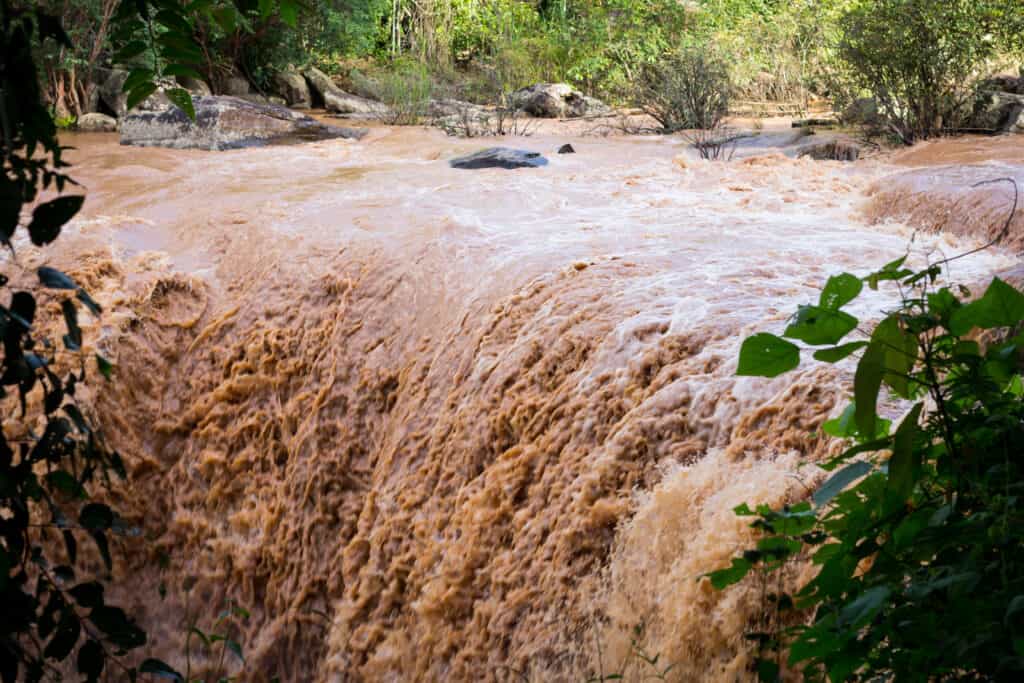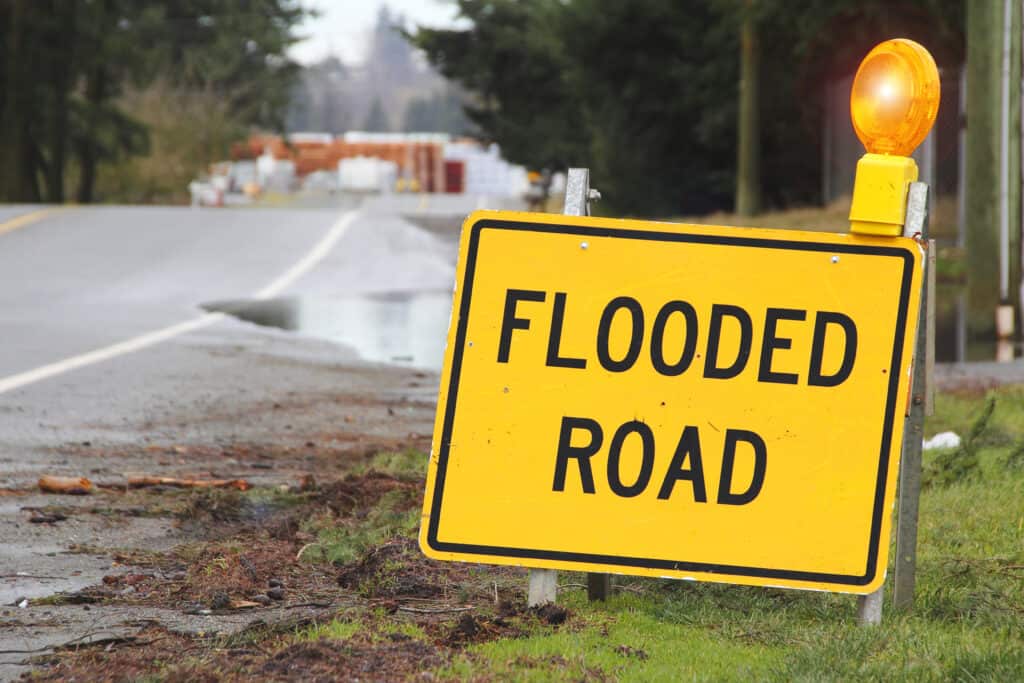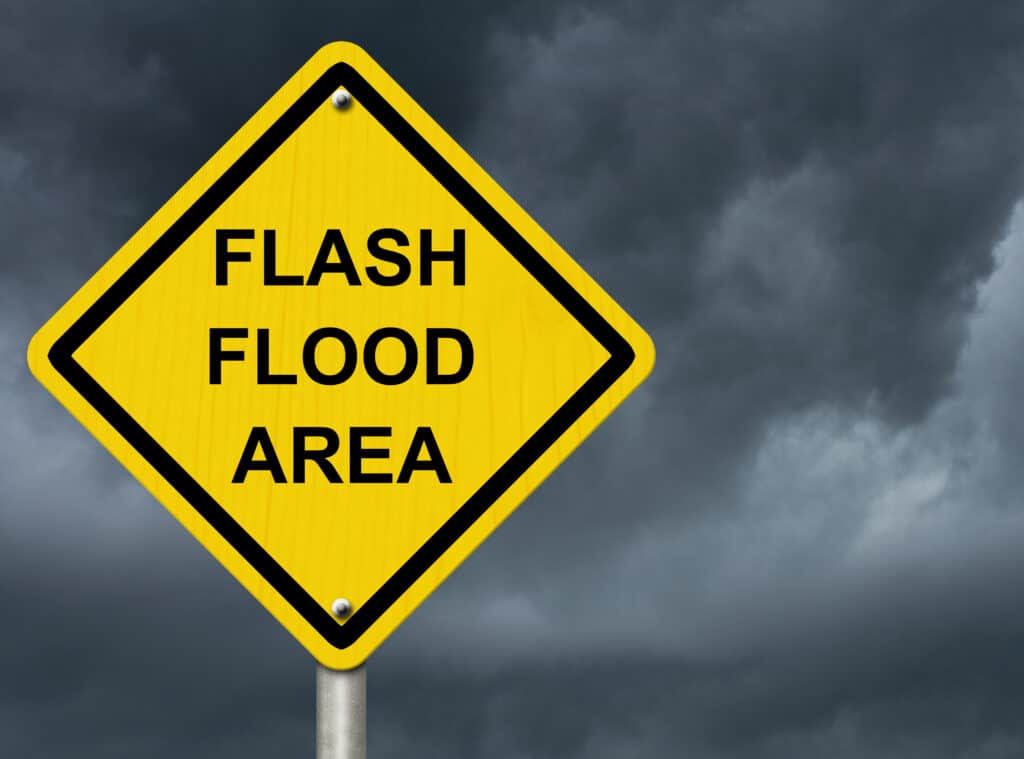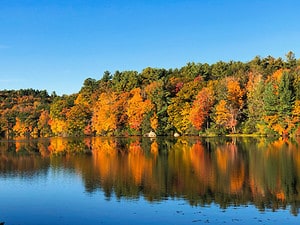The term “flash floods” refers to floods that occur during or shortly after the precipitation. It causes a high surge in water. As a result, flash floods occur in small catchment areas where the drainage basin’s response time is short.
Flash floods can wreak havoc and cause significant negative impacts worldwide. This is partly due to the water’s quick rise and rapid movement.
Although flash floods can occur as a result of a variety of factors, heavy rainfall from thunderstorms is often responsible. Dam or levee breaks and mudslides are also possible causes of flash floods.
Sometimes, ice or floating debris can build up near a natural or artificial obstacle and impede water movement. Upstream flooding may result from water being held back by an ice jam or debris dam. If the obstruction abruptly releases, there could be further flash flooding downstream.
The location and quickness of a flash flood depend on many different factors. These include the magnitude of rainfall, location and distribution, types of vegetation present and their growth, soil type and water content, and terrain and land usage. It often occurs in locations near rivers or lakes and is triggered by high or excessive rainfall, though it can also take place in areas without any nearby bodies of water.
In some cases, rain from the same storm falling over an urban region will induce flooding faster than in the suburbs or the countryside. Water cannot seep through the ground in metropolitan environments due to impermeable surfaces. Therefore it swiftly flows off to low points.
There are instances where flash floods develop despite the absence of ideal thunderstorm conditions and substantial rainfall. Orographic precipitation, which happens when moist air is pushed higher over mountains by the wind flow, is a possible cause of this. Rainfall can be fairly heavy when highly moist air is propelled upward. The steep, rocky ground further facilitates the rapid flow of the rains. This type of flooding is common along the West Coast of the United States or in the European Alps.
The most tragic thing about flash flooding is that people are often unprepared because it happens so suddenly. On one hand, there may be a swift rise in the water if they choose to stay put at home or work, where they could become trapped or left with damaged property. On the other hand, moving to relative safety could mean running into fast-moving water on the way. This contributed to the popular ‘’Turn Around Don’t Drown” (TADD) safety rule.
Flash floods have a significant risk of claiming human lives. Although the majority of fatalities are caused by drowning, there may be some with traumatic damage from being dragged through the debris-filled floodwaters and slammed into immovable objects. When waters back up behind them, temporary “debris dams” made of the debris carried by flash floods usually collapse.
Then, a “wall of water” rushes downstream as a result of these debris dams failing. Several debris dam failure incidents could occur during a flash flood. A wall of water doesn’t always trigger flash floods, but the rapidity of the floodwaters distinguishes them.

Flash flooding occurs when there is excessive rainfall and the ground can’t absorb any more water.
©jirateep sankote/Shutterstock.com
What Does “Turn Around Don’t Drown” Mean?
Turn Around Don’t Drown is a public awareness campaign championed by the National Weather Service. It was created to sensitize people about flood safety rules. Flood-induced mortalities are almost more than any other natural hazard because people often underrate the power and force of water.
According to the Centers for Disease Control and Prevention, driving a car into threatening flood water results in more than half of all drownings caused by flooding. Walking into or close to flood waters results in the second-highest percentage of flood-related fatalities. While most cars can be picked up in water that is only 12 inches deep, an adult can be knocked over by just 6 inches of rushing floodwater.
Thus, the weather body advises people never to move around the barricades obstructing a flooded road. Some other safety guidelines include avoiding places with high flow rates and already-flooded areas. A few others are turning around if you enter a flowing stream and the water rises past your knee and gets out of areas prone to flooding.

If you see a sign that says “Flooded Road,” you should turn around and find an alternative route.
©Eric Buermeyer/Shutterstock.com
Where Do Flash Floods Occur?
Anywhere could experience flash flooding. If there is a lot of rain, it can cause the typically calm creeks and streams in your neighborhood to erupt into violent torrents. Yes, city streets and highway underpasses aren’t left out; they’re susceptible to flash floods.
The Advanced Hydrologic Prediction Service (AHPS) of the National Weather Service is a valuable resource for learning about potential flood zones, warnings, and gauge readings for your location.
How Do You Identify A Flash Flood Region?
Flash flooding is most likely to occur in locations with hard soil that cannot absorb water. This occurs when the soil is either overly saturated or has a low absorption capacity. Runoff accumulates in gullies and streams when the earth cannot absorb water; this runoff combines with extra water to create massive volumes of rapidly moving floodwater.
Flash floods also occur in areas on or close to volcanoes because the rocks are poor at absorbing water.
In addition, a flash flood may be imminent if you detect unusually heavy rain in a particular location.
Keep a watchful eye on the water level if you are close to a waterway during a storm. When rivers or streams rise quickly after a storm, you may be in a flood-prone area; this is especially true in mountainous areas.
Even distant rainfall can be diverted into one region in a short amount of time in hilly areas, which can channel water and produce flooding without any prior notice.

Flash Flood Area signs warn drivers to get out of the area if a storm is approaching.
©karen roach/Shutterstock.com
Flash Floods vs. Floods
Flash floods and floods share some similarities and features. Nonetheless, they’re distinct from one another. Flooding is the term used to describe the presence of water in ordinarily dry locations. Rain is usually the main cause of floods in many nations.
Since there are few outlets for water to move through after rain, densely populated locations like cities often face flooding. However, other factors besides unfavorable weather might also result in flooding. Flooding can occur, even in the absence of rainfall, due to inland water bodies like lakes, rivers, and artificial reservoirs.
While flash floods occur suddenly, the damage wreaked by floods can be contained with accurate weather forecasting and adequate planning. According to the USGS, floods usually result in more property loss, while more fatalities are recorded in flash floods.
Flash floods will likely occur in large areas with dry weather and rocky landscape. Whereas floods are caused when excessive runoff from prolonged rainstorms and, sometimes, from melting snow produces a slower rise in water level over a broader region.
How Are Flash Floods Predicted?
The Flash Flood Guidance (FFG) method was one of the first approaches to predicting flash floods. The technique is based on initial moisture conditions and rainfall data. Rainfall thresholds are designed such that the flow rate determined by the amount of rainfall matches the watercourse’s overflow rate.
FFG is the quantity of precipitation required over a specified area and for a specific time to cause minor streams to reach overflowing flood conditions. The operational hydrologic model, including snow accumulation and melt, is iteratively run across a basin by the computationally efficient NWS RFS FFG operation until the rainfall required to meet runoff is reached.
The semi-distributed and hydraulic models were developed to stimulate discharges. They were also there to stimulate water levels and velocities. This model is used, although it is not calibrated, with parameter values that have been predetermined, taken from the literature, and prior knowledge. A sensitivity analysis using simulated rainfall fields revealed that an uncalibrated model performed within acceptable bounds.
What Are The Effects Of Flash Floods?
The negative impacts of flash floods cut across the people, environment, and economy. Rebuilding and resettling devastated areas to return to normalcy usually takes years because homes, vehicles, hospitals, highways, water tanks, bridges, and other infrastructure are all devastated during flash floods.
It is not surprising that people can be killed or suffer significant injuries from these natural disasters, given their unpredictable nature.
Flash floods can carry boulders and other large pieces of debris. Homes may sustain severe structural damage, rendering them unsafe for living. In addition, huge items of property, such as vehicles, may be carried away in the mix.
Flood waters carry sand, silt, and other debris as they move. The flash flood starts to deposit this debris when its speed slows. Large volumes of silt and other debris left over after floods can complicate travel and be expensive to clear.
Environmental pollution, loss of pets, massive soil erosion, and closure of local businesses are some of the other devastating impacts of flash flooding.
Up Next…
Check out a few of our other articles based on natural disasters.
- Deadliest Natural Disasters Of All Time – Find out just how bad these were.
- 7 Strongest Hurricanes On Earth – Just how much damage did they cause?
- 5 Biggest Earthquakes On Earth – Read about where and when they happened.
- 4 Terrifying Flash Floods In Utah – Discover the impact of flash floods in Utah.
The photo featured at the top of this post is © swa182/Shutterstock.com
Sources
- Weather, Available here: https://www.weather.gov/phi/FlashFloodingDefinition
- Science Direct, Available here: https://www.sciencedirect.com/topics/earth-and-planetary-sciences/flash-flood
- Difference Between, Available here: http://www.differencebetween.net/science/nature/difference-between-flood-and-flash-flood/
- Sunny Sports, Available here: https://www.sunnysports.com/blog/identify-flash-flood-region/
- Weather, Available here: https://www.weather.gov/jetstream/flood
Thank you for reading! Have some feedback for us? Contact the AZ Animals editorial team.






